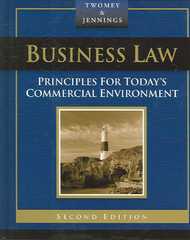Question
solve a version of the specic factors model to see how trade can create both winners and losers through its eects on real factor incomes.
solve a version of the specic factors model to see how trade can create both winners and losers through its eects on real factor incomes. There is a single country, Home, and two sectors, 1 and 2. Home is endowed with L units of labor, K 1 units of capital specic to sector 1, and K 2 units of capital specic to sector 2. Household preferences in Home are Cobb-Douglas with potentially asymmetric weights: U (C1, C2) = C S 1 C 1S 2 where C1 and C2 denote the household's consumption of goods 1 and 2 respectively. The parameter S (0, 1) measures how much the household likes good 1 relative to good 2. The production technology available is the same in each sector, and is given by the following Cobb-Douglas production function: Xi = K1 i L i where Xi , Ki , and Li denote the output, capital input, and labor input of sector i respectively. The parameter (0, 1) measures how important labor is for production relative to capital. In what follows, assume that factor endowments are: L = 1 K 1 = 1 K 2 = 1 and that the weight on labor in the production function is = 2 3 . We will examine how dierent values for the parameter S aect the welfare gains from trade. 1 First, we will solve for demand and supply assuming that the goods prices p1 and p2 (and hence the relative price pr p1/p2) are known. Let w, r1, and r2 denote the wage, rental rate of sector 1 capital, and rental rate of sector 2 capital respectively. Demand The utility maximization problem for a household with income I is: max C1,C2 C S 1 C 1S 2 s.t. p1C1 + p2C2 = I (a) What is equilibrium relative consumption, Cr C1/C2, given goods prices? Supply The prot maximization problem for a rm in sector i is: max Ki,Li piK1 i L i riKi wLi (b) Write down the rst-order conditions for this problem. Now note that capital market clearing requires: Ki = K i for i {1, 2}. (c) What is the equilibrium relative allocation of labor across sectors, Lr L1/L2, given goods prices? (d) What is equilibrium relative output, Xr X1/X2, given goods prices? Autarky Now suppose that Home is in autarky. Goods market clearing therefore requires that consumption equals production: Ci = Xi for i {1, 2}. (e) What is the equilibrium relative goods price pr in autarky? How does the relative price change with S? Why? Now note that labor market clearing also requires: L1 + L2 = L. (f) What is the allocation of labor in each sector, L1 and L2? (g) What are real factor incomes in terms of goods 1 and 2, i.e. w p1 , w p2 , r1 p1 , r1 p2 , r2 p1 , and r2 p2 ? 2 Trade Now suppose that Home can trade with the rest of the world at some prices p W 1 , pW 2 and suppose that the world relative price is p W r p W 1 /pW 2 = 1. (h) Repeat your calculations in parts (f)-(g) to determine real factor incomes under trade. (i) How does trade aect real factor incomes for (i) workers, (ii) owners of sector 1 capital, and (iii) owners of sector 2 capital? (Hint: your answer will depend on whether S < 1 2 , S = 1 2 , or S > 1 2 ). (j) Explain the intuition for your ndings in part (i).
Step by Step Solution
There are 3 Steps involved in it
Step: 1

Get Instant Access to Expert-Tailored Solutions
See step-by-step solutions with expert insights and AI powered tools for academic success
Step: 2

Step: 3

Ace Your Homework with AI
Get the answers you need in no time with our AI-driven, step-by-step assistance
Get Started


